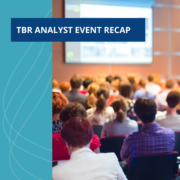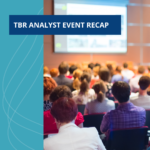SAP Sapphire 2025: Legacy Application Leader Moving Confidently Into a Data and AI Future
Staking a claim in a best-of-suite future
At SAP Sapphire 2025, one thing became immediately clear: SAP is no longer chasing the cloud market — it is positioning itself to define it. While best-of-breed has long been the enterprise default, a growing segment of the market is leaning toward consolidation: fewer vendors, tighter integration, faster outcomes. SAP sees an opening. With its dominance as a system of record and a broad portfolio spanning platforms and line-of-business (LOB) suites, the company believes it is uniquely equipped to serve these best-of-suite buyers and made a compelling case at Sapphire that it is actively working to turn this vision into reality.
SAP’s messaging has focused heavily on customers already operating in the cloud, shifting attention away from the sizable portion of its base still tethered to ECC (ERP Central Component). The forward-looking emphasis may be warranted. Although cloud migrations remain a strategic priority, they have been at the center of SAP’s story for the better part of a decade. While the customer mix still skews toward legacy deployments, TBR estimates that cloud revenue accounts for more than 60% of SAP’s total corporate revenue, presenting a solid base from which to expand contract sizes.
In addition to migration efforts, the company has built out a suite of integration, robotic process automation and data assets — many with high attach rates — that are driving much of its commercial cloud momentum. While TBR believes SAP will continue steadily transitioning legacy customers to the cloud, its land-and-expand strategy among new logos (born-in-the-cloud, midmarket) and existing customers leaning into modernization will provide ample growth opportunities to build on top of migration-related gains. For this reason, TBR believes SAP was justified in prioritizing its platform-centric cloud strategy at Sapphire 2025. The company has built a compelling cloud business, and that road map deserves to be in the spotlight.
Building an agentic flywheel
SAP’s central metaphor this year — the “flywheel” — describes a loop in which enterprise applications feed business data into a semantic layer, which powers AI agents that act on the data and push outcomes back into the apps. Put simply: if you own the context, you control the outcome. SAP believes its depth of structured business data gives it a defensible advantage in the race toward agentic AI. Fragmented stacks, the company argues, are the Achilles’ heel of enterprise automation. SAP promises to reduce the cost and complexity of AI adoption by delivering deeply integrated, outcome-oriented capabilities across its entire suite of products.
The state of Joule as a UI for the AI era
SAP wants 2025 to be the year agents move from prototype to production. Joule remains the user interface (UI), but it is now positioned as an orchestration layer, not just a chatbot. The company showcased use cases ranging from accounts receivable prioritization to automated financial close and proactive risk flagging. These scenarios emphasized traceability. For example, each step is visible to the end user, and each recommendation is auditable. That transparency, enabled by LeanIX, signals SAP’s commitment to building enterprise-grade controls around automation.
Today, most of these agents are operating in relatively structured environments. Financial workflows, inventory management and procurement tasks offer well-bounded problems. The leap to agents that navigate fuzzier terrain — customer onboarding, scenario planning or partner collaboration — has not happened yet. Agentic systems will continue to be built on a use-case-by-use-case basis, which takes time. SAP is developing more tasks and, at the event, showed a demo of Joule working through a tariff shock scenario. It featured each member of a fictional C-Suite reacting in real time using embedded AI: the CFO reallocating capital, the chief revenue officer rerouting demand, the COO managing supply constraints, and the chief human resources officer rebalancing skills.
In TBR’s opinion, the demo felt like an oversimplification of a complex issue, but we were still impressed by the information an agent could gather and the actions it was able to execute. Obviously, agentic AI stands to be highly disruptive to SaaS workflows, and TBR believes SAP is playing the game well. Long-term, the breadth of the company’s ERP and LOB portfolios offers a massive amount of whitespace for innovation, enabling the company to continue attacking the opportunity on a use-case-by-use-case basis as it rides the wave.
Prioritizing semantic cohesion over data consolidation
SAP has spent years refining its data strategy. While Datasphere offered value in real-time processing, it was never intended to serve as a central data platform — especially with Snowflake, Databricks and Google Cloud leading in that space. The launch of Business Data Cloud (BDC) acknowledges this external reliance, advancing the same ambition Datasphere once aimed for: a harmonized, semantically enriched, agent-ready data layer.
BDC’s zero-copy architecture and native integrations with platforms like Databricks reflect this evolution. SAP is betting on semantic fabrics, not data lakes. Knowledge graphs across HR, finance and procurement add structure, while embedded governance ensures auditability. This plays to SAP’s strengths. The offering feels tailored to existing customers and midmarket newcomers, especially those with aggressive AI ambitions.
That said, harmonized data remains one of the hardest problems in enterprise IT. BDC assumes a level of data maturity that many SAP customers have not yet achieved. A large portion of the install base remains on premises, but for those already in the cloud — or willing to invest — the value proposition is becoming clearer. And SAP’s traction among net-new logos suggests the offering resonates with digital-native buyers looking to operationalize AI quickly.
Turning channel partners into strategic collaborators
The biggest partner takeaway from Sapphire was that SAP is no longer content with resell-and-implement motions. It wants deeper collaboration. The flywheel — applications, data, AI — only spins fast enough when partners are embedded into engineering, orchestration and execution. That shift has forced SAP to rearchitect how it manages partner access, tools and territory, with trust becoming a central pillar of its partner strategy.
SAP is also handing over the sales motions for its innovation stack. Partners now have access to the same internal tools used to build and deploy agents: Joule Studio, Prompt Optimizer, LeanIX, SAP Build and WalkMe. This is not only enablement but also an invitation to build within the stack. But access comes with expectation. These tools require fluency, not just familiarity. SAP wants to work with a deeper class of partner that can move from implementation to cocreation.
Equally important: territory. SAP is expanding partner-led coverage, particularly in North America and Europe. The new SAP Referral Program, scheduled to launch in 3Q25, formalizes this shift. Strategic partners will now own more of the Customer Value Journey — sales, delivery and post-sales engagement — especially in midmarket and vertical contexts.
Perhaps the most strategic move, though, is cultural. SAP is not just training partners; it is also increasingly transferring responsibility. KPMG is delivering structured Joule certifications. Accenture is codeveloping production agents. Capgemini is integrating Databricks into SAP’s data stack. Meanwhile, PartnerEdge, SAP’s overall partner program, is evolving to reward cloud performance, AI capability and vertical differentiation. Success in these areas will see the greatest investment and visibility from SAP.
SAP moves ahead with strategic clarity
All told, Sapphire 2025 marked a turning point, not because SAP introduced a radically new vision but because the company finally appears ready to execute on the one it has been quietly building for years. The narrative has matured, the tools are in place, and the platform is coherent. And the partners, customers and product ecosystem are starting to move together. Some heavy lifting remains, such as around migrations, data harmonization and partner fluency, but if SAP can stay focused on delivering scalable value through agentic AI, integrated data platforms and partner-enabled execution, the next chapter of the company’s growth story will look a lot less like catching up to the cloud and a lot more like leading in it.

 Technology Business Research, Inc.
Technology Business Research, Inc. Technology Business Research, Inc.
Technology Business Research, Inc. Technology Business Research, Inc.
Technology Business Research, Inc.